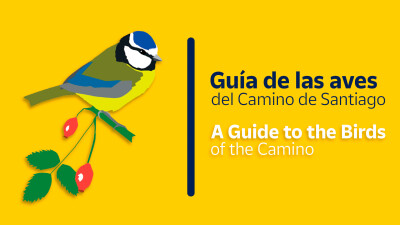
Discover and enjoy the fauna of the Pilgrims' Routes to Santiago de Compostela. This is the aim of A Guide to the Birds on the Camino de Santiago, a journey through the different itineraries observing the most common species of birds.
With text and illustrations by the biologist and bird expert Nacho Munilla, this booklet brings together the birds that usually accompany people on pilgrimage along the different Pilgrims' Routes to Compostela. It brings together 12+1 species, all of them very common and easy to spot.
This guidebook is born in the framework of the Social Responsibility initiative of Correos #CaminoSostenible. Following in the footsteps of the Guía de árboles del Camino Francés, it seeks to raise awareness of the natural wealth of the Camino de Santiago, delving into one of the main leitmotifs of the initiative: only that which is known is protected.
A large, schematic illustration is included for each bird to facilitate its identification, a brief description of its physical characteristics and some details of its habits, character or how it relates to the people it flies over.
Each sheet also includes the Road where it is present, the period of sighting and information on the status of the species to try to contribute to its conservation: safe, vulnerable or in danger of extinction.
In this article we collect some of the characteristics of the 12+1 species of birds that pilgrims can observe on their pilgrimage to Santiago.
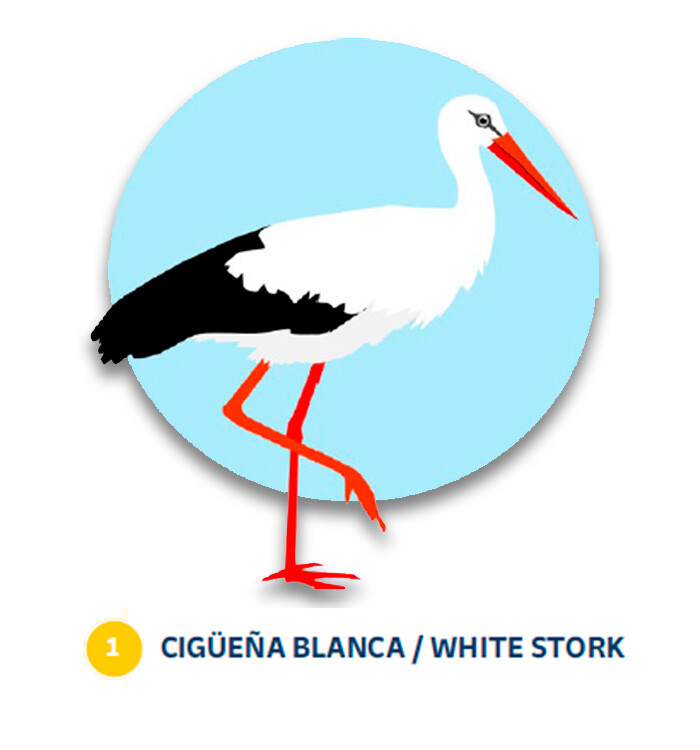
White stork. Ciconia ciconia. A very large White bird with a long neck and black flight-feathers. Bright red and quite long legs and beak. Flying silhouette with neck outstretched and legs extending far beyond the tail. Builds huge nests on tres, buildings and other human-made structures. Dwells in open and rather flat landscapes where croplands and wetlands abound.
Location: Camino Francés, de Invierno, Portugués, Mozárabe, Vía de la Plata.
Sighting: from March to September but some will stay for the winter.
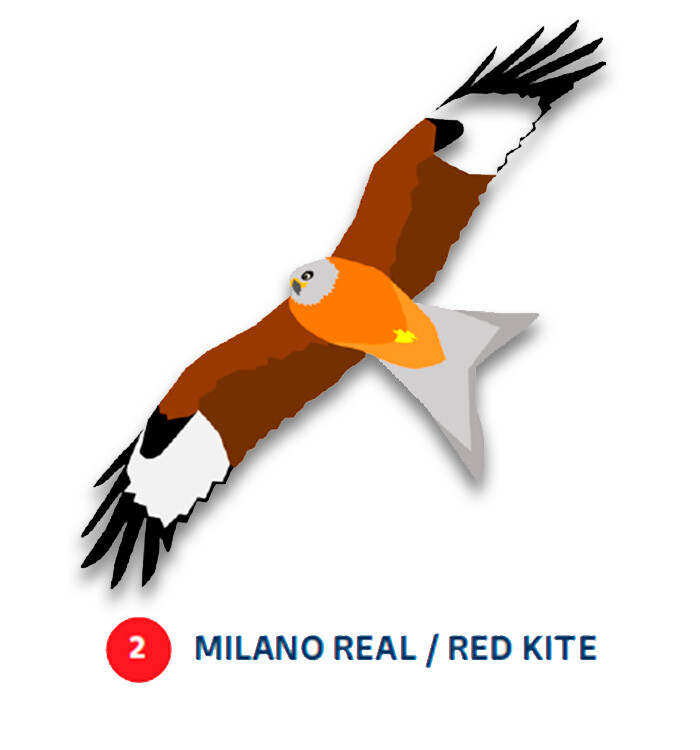
Red kite. Milvus milvus. A fairly large raptor with long and raher narrow wings and a deeply forked tail. The whitish as though translucent patch towards the ened of the wings is also a useful feature for positive identification. There is no better relief for the pains of the Camino than enjoying the graceful, buoyant and effortless flight of the red kite. Soars at a low height over open landscapes.
Location: Camino Francés, de Invierno, Camino Portugués, Mozárabe-Vía de la Plata.
Sighting: all year around.
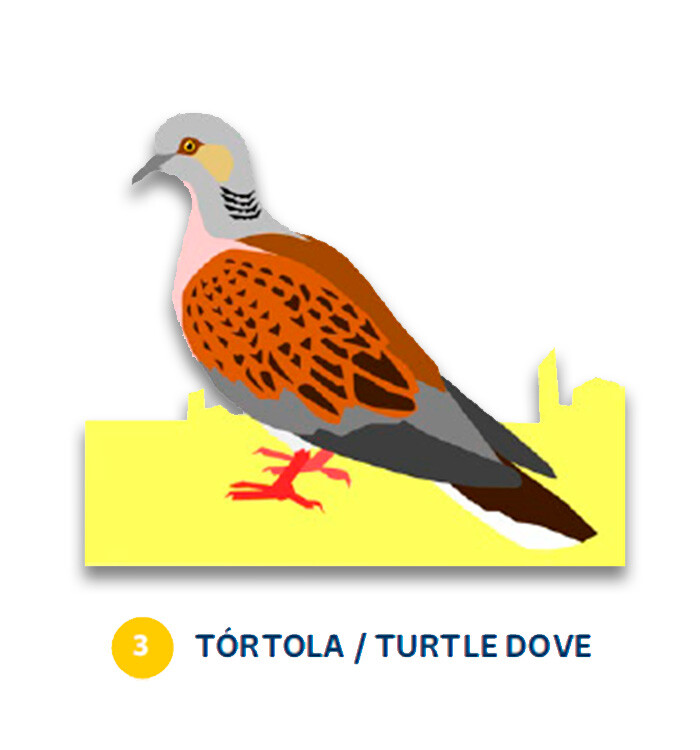
Turtle dove. Streptopelia turtur. A slender and graceful dove with a plumage that combines chestnut upperparts with grey and pinkish tones on head and chest. The embracing purring call of the turtle dove will certainly bring confort to the pilgrims when crossing Woodland areas on hot summer days. The black and White rimmed tail is a feature that catches the eye if percance you should happen to flush one.
Location: Camino Francés, de Invierno, Portugués, Mozárabe-Vía de la Plata, Norte, Primitivo, Inglés and Camino a Fisterra.
Sighting: from March to September.
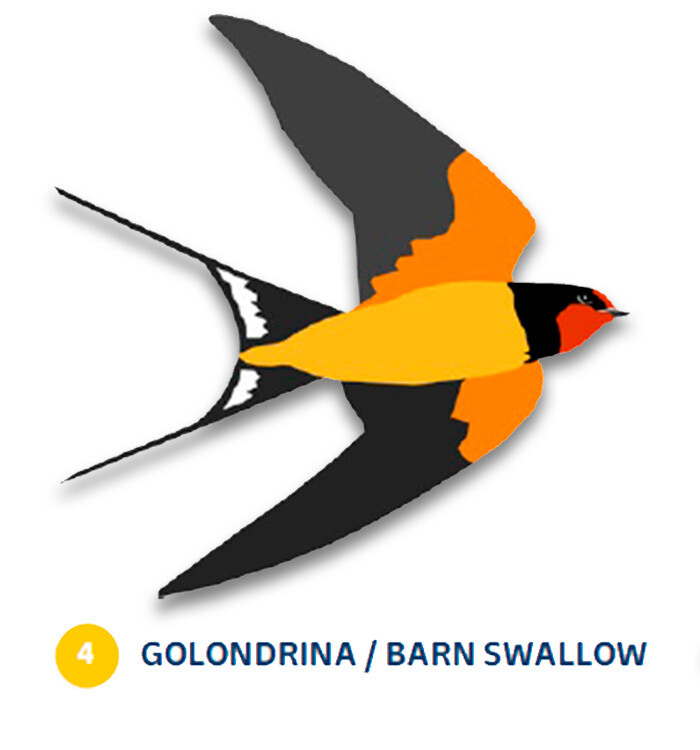
Barn swallow. Hirundo rustica. Shiny black upperparts contrasting with a creamy belly and a red throat. Surprisingly long and deeply forked tail. A fearless flyer, the barn swallow loves to sweep and swoop close to the ground in front of people. Nests in a cup built from mud pellets fglued under roofs in villages and country towns. Visits open wáter bodies and wáter soaked meadows in full bloom.
Location: Camino Francés, de Invierno, Portugués, Mozárabe-Vía de la Plata, Norte, Primitivo, Inglés and Camino a Fisterra.
Sighting: from March to September.
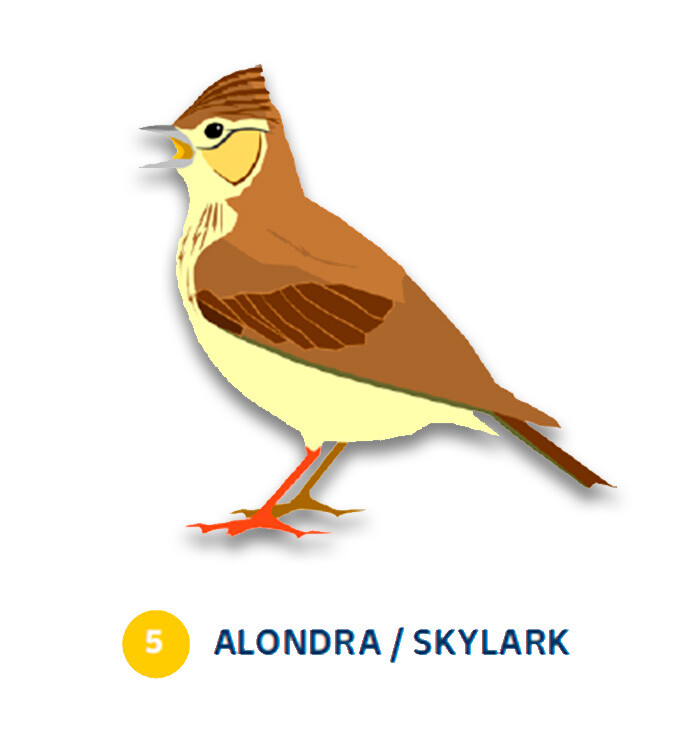
Skylark. Alauda arvensis. A small ground dwelling bird with streaked Brown plumage and a short crest. The feathers at the sides of the tail are white. Loves to sing in the air in the early morning and in the evening. The cheerful song of the skylark will bring joy to the soul of the early rising pilgrim. Inhabits open landscapes covered by low vegetation. From the seaside to the mountain top.
Location: Camino Francés, de Invierno, Portugués, Mozárabe-Vía de la Plata, Norte, Primitivo, Inglés and Camino to Fisterra.
Sighting: all year around.
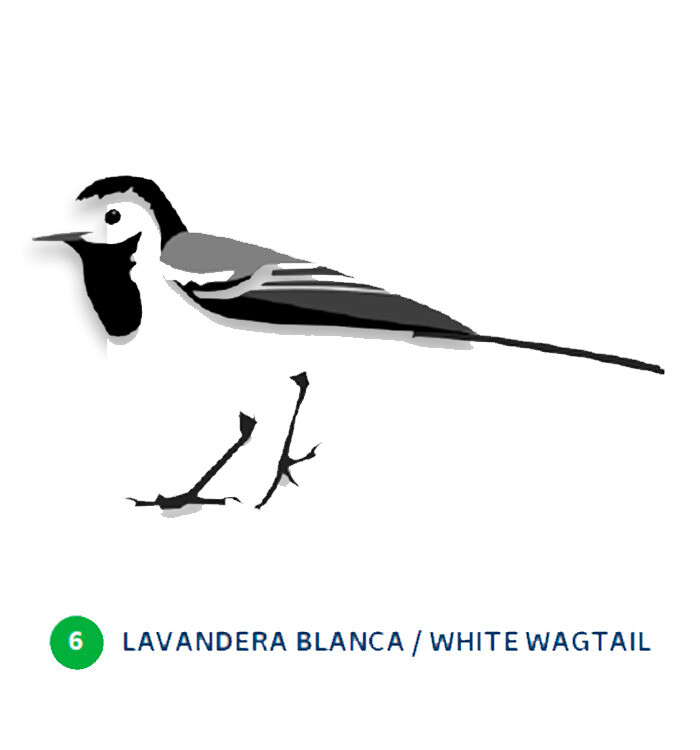
White wagtail. Motacilla alba. A slender Little with a long tail that constantly wags up and down. Contrasting black and white pattern quite unmistakable. Walks and hops and leaps ahead of pilgrims performing short flights usually accompanied by a characteristic two-note chirrup. All kinds of waterside hábitats, open agricultural landscapes and human settlements of any size.
Location: Camino Francés, de Invierno, Portugués, Mozárabe-Vía de la Plata, Norte, Primitivo, Inglés and Camino to Fisterra.
Sighting: all year around.
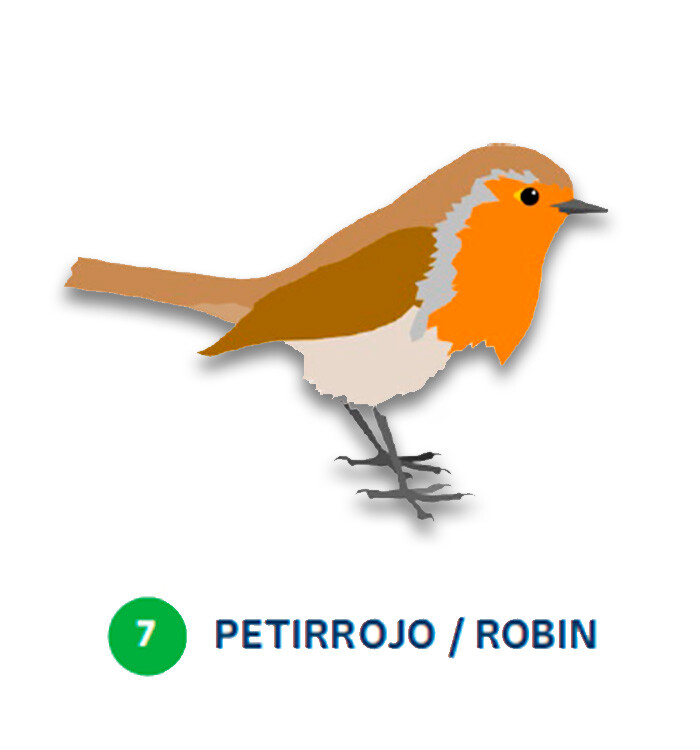
Robin. Erithacus rubecula. Unmistakable, no other Little bird on the Camino features a large orange patch over its face and chest. Smart, lively and curious, the robin likes to observe people. In cool and shaded landscapes with broad-leaved tres including parks and gardens. The melodious and rather melancholic song of the robin can be heard in all seasons.
Location: Camino Francés, de Invierno, Portugués, Mozárabe-Vía de la Plata, Norte, Primitivo, Inglés and Camino to Fisterra.
Sighting: all year around.
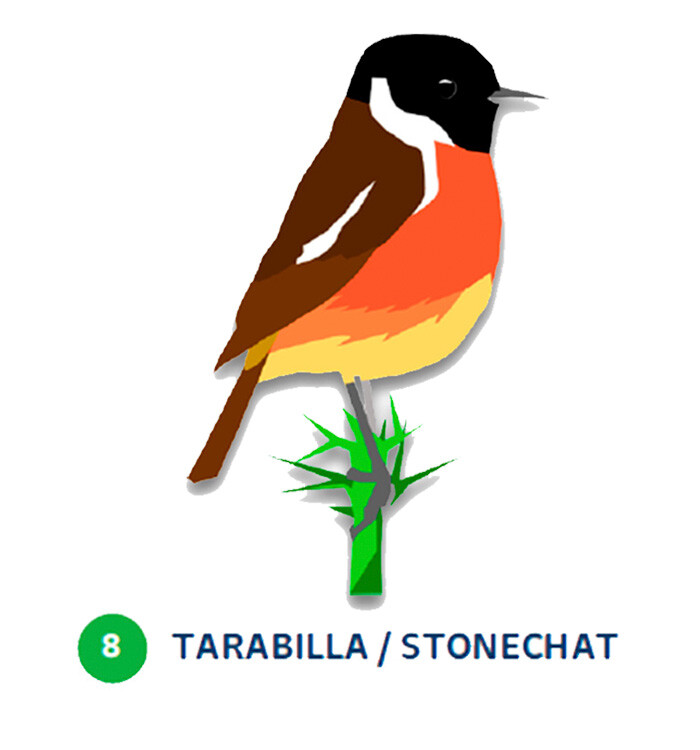
Stonechat. Saxicola rubicola. A fluttery small bird with a black head and a brick red chest that perches upright, usually at full sight on the tip of shrubs. A white scarf shows on both sides of the neck. Often flicks wings and tail. Greets the pilgrims that come across its domains with a characteristic and rather harsh call composed of one or two notes. Lives in open landscapes with bushes and shrubs.
Location: Camino Francés, de Invierno, Portugués, Mozárabe-Vía de la Plata, Norte, Primitivo, Inglés and Camino to Fisterra.
Sighting: all year around.
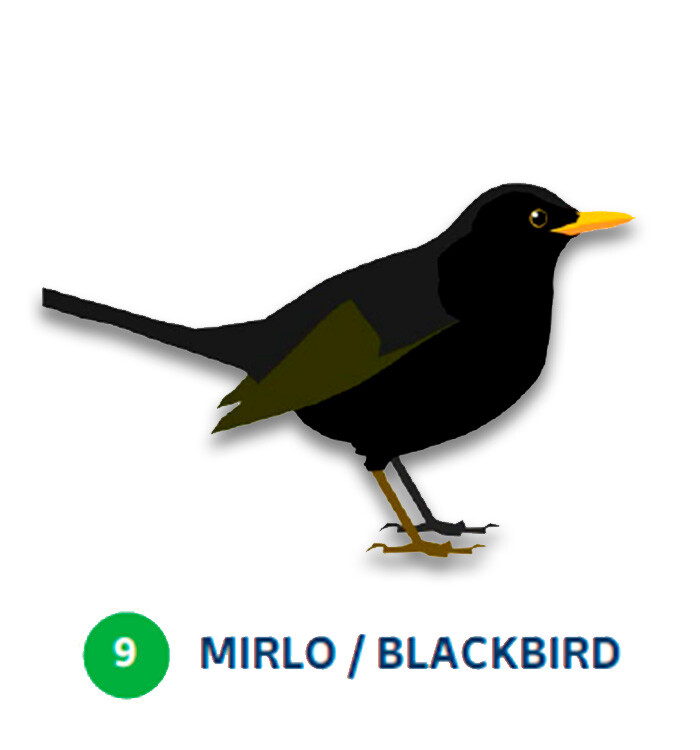
Blackbird. Turdus merula. A medium-sized bird with black (male) or dark-brown (female) plumage and (only males) yellow bill and eye ring. May give us a look while catching earthworms in the nearby grass fields. Smart and a bit noisy, the blackbird is quite a good mellow singer. Incredibly adaptable, can be found almost anywhere.
Location: Camino Francés, de Invierno, Portugués, Mozárabe-Vía de la Plata, Norte, Primitivo, Inglés and Camino to Fisterra.
Sighting: all year around.
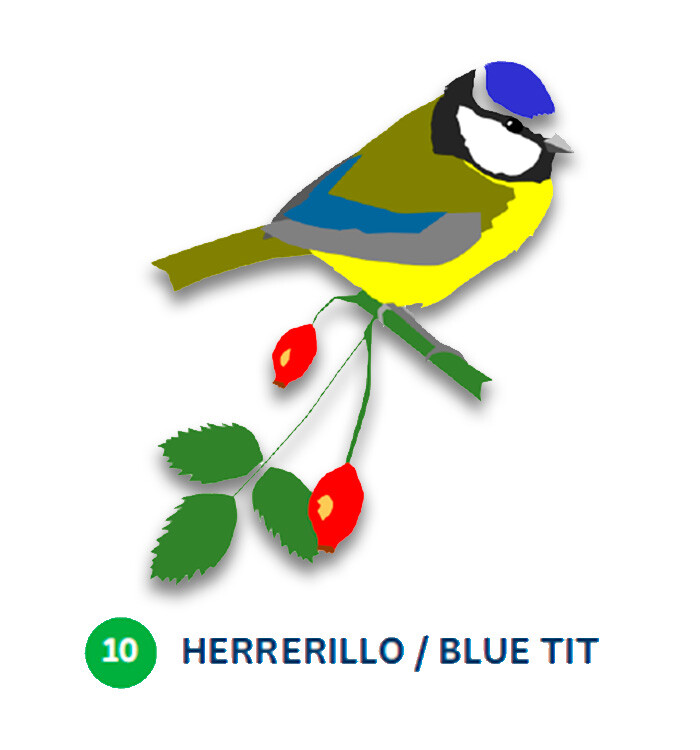
Blue tit. Cyanistes caeruleus. A small, hyperactive and brave little bird with a plumage that combines blue, black and yellow in a dicstintive and unmistakable pattern. The blue colour is on its wings and cap. Likely to flirt ahead of us for a while in and out of the hedges of the Camino. A bird true to broad-leaved native woodland.
Location: Camino Francés, de Invierno, Portugués, Mozárabe-Vía de la Plata, Norte, Primitivo, Inglés and Camino to Fisterra.
Sighting: all year around.
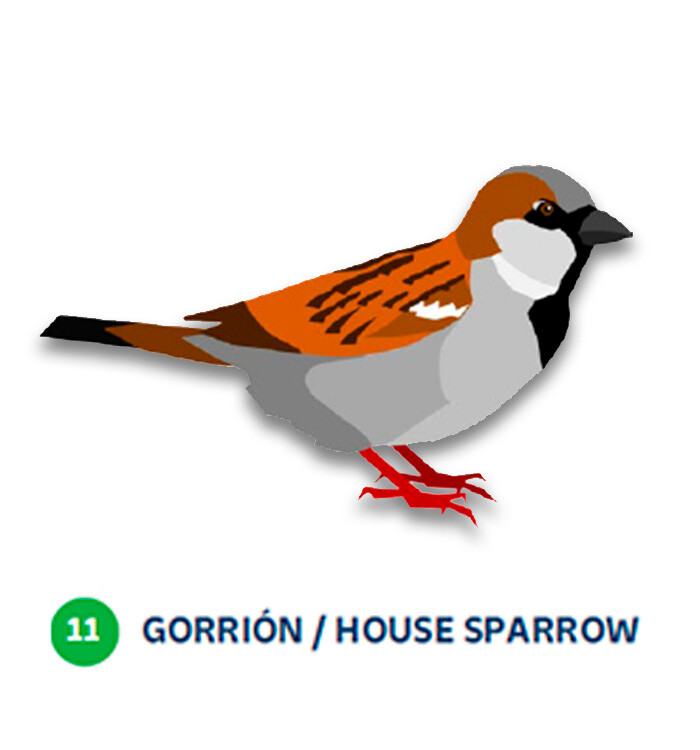
House sparrow. Passer domesticus. A robust little brown bird with greyish underparts and a black bib. Bill short and thick. Hops around. Lively and noisy, the cheerful chatter of the house sparrows will greet the pilgrim throughout all the towns and villages of the Camino.
Location: Camino Francés, de Invierno, Portugués, Mozárabe-Vía de la Plata, Norte, Primitivo, Inglés and Camino to Fisterra.
Sighting: all year around.
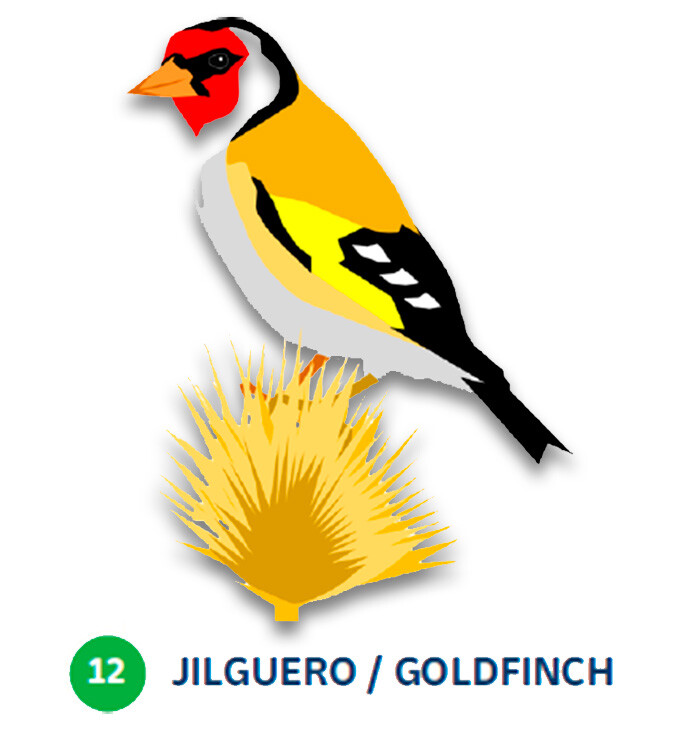
Goldfinch. Carduelis carduelis. A multi-coloured and delicate little bird with a red face and a pointed bill. Wings are black with a wide yellow stripe along the centre. Goldfinches usually fly in pairs or small groups greeting everyone with their cheerful flight call. They delight in the seeds of the prickly thistle.
Location: Camino Francés, de Invierno, Portugués, Mozárabe-Vía de la Plata, Norte, Primitivo, Inglés and Camino to Fisterra.
Sighting: all year around.
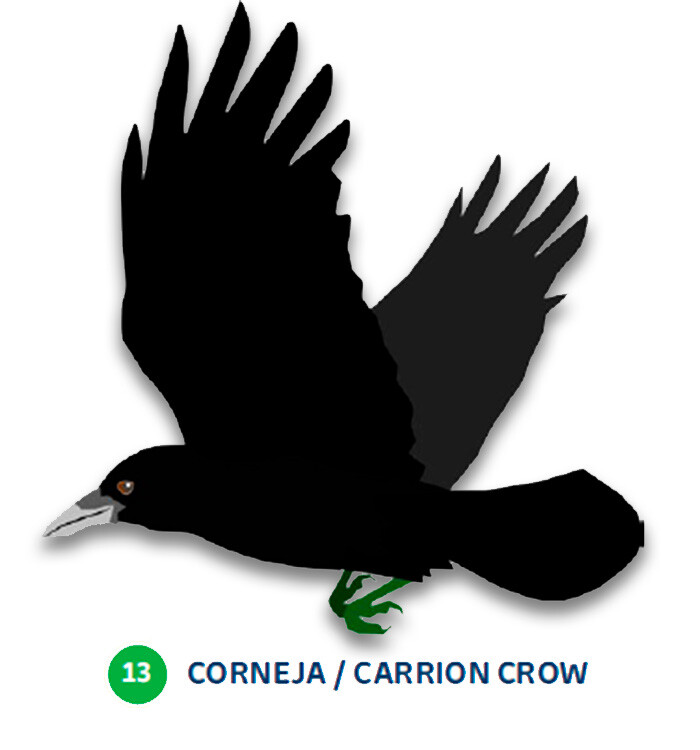
Carrion crow. Corvus corone. A large and completely black bird with a fan shaped tail. Powerful but somewhat lazy flight. Intelligent and social, they have adapted to a diverse array of habitats. They like to perch on the top of the trees and greet the passers-by with a repertoire of harsh and vibrant calls. Mostly a ground forager.
Location: Camino Francés, de Invierno, Portugués, Mozárabe-Vía de la Plata, Norte, Primitivo, Inglés and Camino to Fisterra.
Sighting: all year around.
You can get the bird guide at the Correos offices corresponding to the following Rutas Jacobeas:
Camino Francés: Burguete, Jaca, Pamplona, Logroño, Burgos, León, Ponferrada, Sarria.
Camino Portugués: A Guarda, Tui, Pontevedra.
Camino Inglés: Ferrol.
Camino del Norte: San Sebastián, Bilbao, Santander, Gijón, Ribadeo.
Camino Primitivo: Oviedo, Lugo.
Camino de Inveierno: Monforte de Lemos.
Camino Mozárabe-Via la Plata: Ourense.
And you can also get it at the Santiago de Compostela office (Rúa do Franco, 4; 2 minutes from Plaza del Obradoiro).
We hope that this guide will help you to enjoy the natural heritage of the Camino de Santiago and that it will contribute to its conservation.
Good and sustainable Camino, pilgrims!
Your email address will not be published.
Mandatory fields are marked with *



